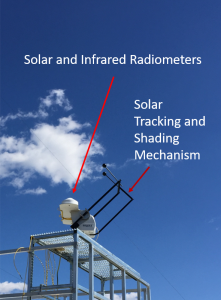PAM Site
Visit the Photochemical Assessment Monitoring Site
Measurements made at the Rutgers Photochemical Assessment Monitoring (PAM) site are used to assesses air quality and lower atmospheric conditions in Central New Jersey. The site is equipped with a wide array of surface and remote sensor measurements and is located on Horticulture Farm #3. A twenty meter tower equipped with temperature, relative humidity, and wind measurements at two meters, ten meters, and twenty meters provide continuous monitoring of the surface layer, which is thin layer of atmosphere closest to the surface. Exchanges between the surface and atmosphere take place in the surface layer.
The PAM Site is also equipped with a comprehensive, state-of-the-art system that measures the incoming solar and infrared radiation fields and the net radiation exchange (incoming minus outgoing). The incoming solar radiation field is comprised of a direct component, which is the solar radiation coming from the direction of the sun’s disk, and a diffuse component, which is the solar radiation coming from all other directions. Measurements across the full range of incoming solar wavelengths, termed “broadband”, and across small increments in the spectrum, termed “narrowband” are made at the site.
A vertically-pointing laser, known as a laser ceilometer, measures the lowest cloud-base height every 15 seconds. Winds and temperatures in the lowest 3-5 kilometers of the atmosphere are monitored continuously. A profile of the wind speed and direction is measured by a vertically-pointing Doppler radar operating at a frequency of 915 MHZ. This radar measures the velocity of turbulent eddies as they pass above the site being moved with the wind along three different beams, one vertical and two slightly off vertical. Once per hour large speakers pointed toward the sky, toward zenith we call it, broadcast sound waves that are a form of turbulence. As these sound waves move away from the speakers and into the lower atmosphere, we use the Doppler radar to measure their speed, which is directly related to the atmospheric temperature. As the sound passes through different layers of the lower atmosphere and its speed changes slightly in response to temperature changes, we can construct a temperature profile. Knowledge of the temperature profile is important because it impacts the vertical exchanges between the surface and lower atmosphere.
-

A quick summary of radiation instrumentation and terminology may be helpful. When we look at the clear daytime sky, we see a stream of visible radiation (radiation that we can detect with our eyes) emanating from the sun’s disk, which is known as direct-beam radiation (or just direct radiation). We also see a blue sky, which means that blue light is reaching our eyes from directions other than along a direct line from the sun’s disk. This visible light coming from other directions is known as diffuse radiation. The total amount of visible radiation that reaches our eyes (or the surface) is the sum of the direct and diffuse radiation. I have used visible radiation as an example, but much of the radiation that comes from the sun cannot be detected by our eyes and lies in a region known as the near-infrared. When skies are clear, the direct beam component of the solar radiation field is much greater than the diffuse component, but as cloud cover increases, the direct and diffuse components converge until they are equal in complete overcast.
Radiation measurements that include almost all of the relevant wavelengths emitted from the sun and the Earth are referred to as “broadband” measurements, while those that include only a small fraction of the radiation in a particular part of the radiation spectrum are called “narrowband” measurements. If narrowband measurements are made incrementally across a large portion of the radiation spectrum, the instrument is referred to as a “spectrometer”. Irradiance refers for radiation falling on a surface from multiple directions, while radiance refers to radiation falling on a surface from a single direction. Integrating the radiance from all individual directions equals the irradiance.
There are three classifications of broadband radiometers: pyranometers, pyrgeometers, and pyrheliometers. Pyranometers measure a large portion of the solar radiation emitted by the sun. Pyrgeometers measure a large portion of the infrared radiation emitted by the Earth and its atmosphere. A pyrheliometer is a special type of pyranometer designed to measure solar radiation emitted from a specific direction, typically along the direct line to the solar disk.
The PAM Site is equipped with a full suite of radiometric measurements.
Pictured here is the centerpiece of the radiation system, a sun-tracking direct, diffuse, and total broadband solar and broadband infrared radiation measurement suite. The extended arms with spheres on the end are continually positioned such that the spheres occult the solar disk, producing a continuous shadow on the shaded solar pyranometer, while a perpetually unshaded pyranometer sits nearby. A “normal-incidence” pyrheliometer (or NIP) follows the sun’s disk as it progresses across the daytime sky. Baseline total broadband solar irradiance is measured using an unshaded Kipp and Zonen CMP22 pyranometer, which has a spectral range of 200 to 3600 nm and a response time of 5 s. This pyranometer has a zero offset, one measure of accuracy, of <3 Wm^2. Diffuse irradiance is measured using a shaded Kipp and Zonen CMP21, which has a spectral range of 285 to 2800 nm, a response time of 5 s, and a zero offset of <7 Wm^2.
-
-
-
-
-